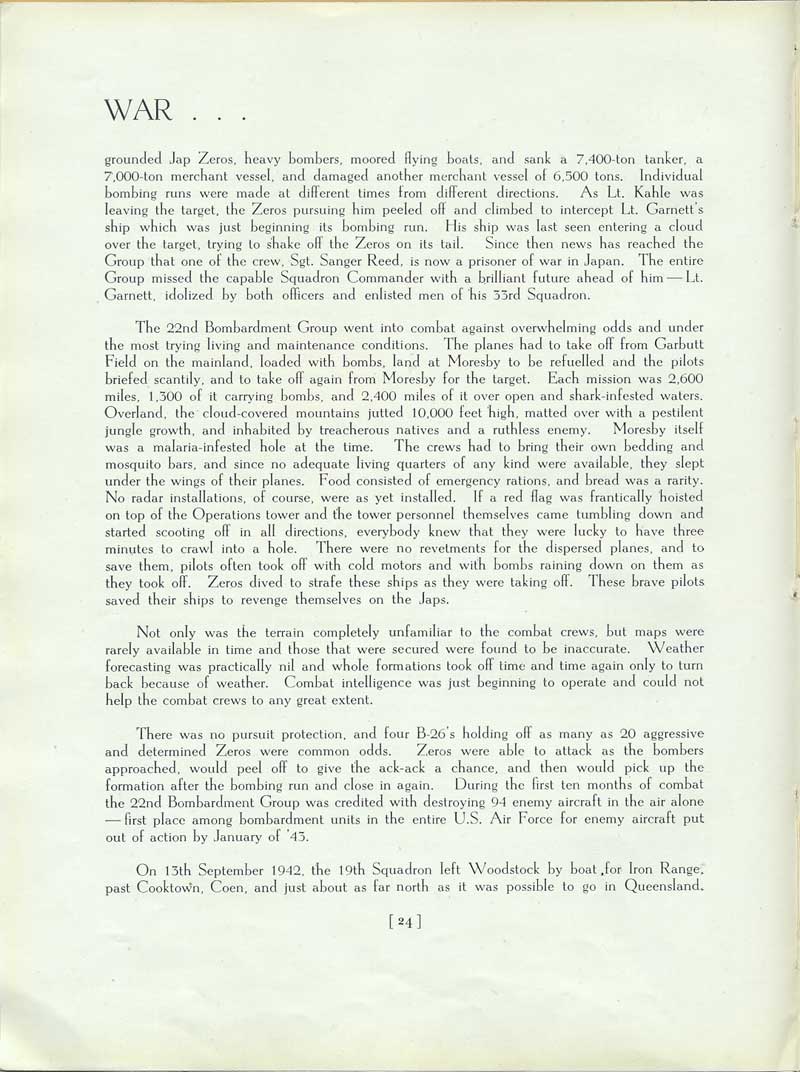
Next page...

| WAR... grounded Japanese Zeros, heavy bombers, moored flying boats, and sank a 7,400-ton tanker, a 7,000-ton merchant vessel, and damaged another merchant vessel of 6,500 tons. Individual bombing runs were made at different times from different directions. As Lt. Kahle was leaving the target, the Zeros pursuing him peeled off and climbed to intercept Lt. Garnett's ship which was just beginning its bombing run. His ship was last seen entering a cloud over the target, trying to shake off the Zeros on its tail. Since then news has reached the Group that one of the crew, Sgt. Sanger Reed, is now a prisoner of war in Japan. The entire Group missed the capable Squadron Commander with a brilliant future ahead of him - Lt. Garnett, idolized by both officers and enlisted men of 'his 33rd Squadron. The 22nd Bombardment Group went into combat against overwhelming odds and under the most trying living and maintenance conditions. The planes had to take off from Garbutt Field on the mainland, loaded with bombs, land at Moresby to be refueled and the pilots briefed scantily, and to take off again from Moresby for the target. Each mission was 2,600 miles, 1,300 of it carrying bombs, and 2,400 miles of it over open and shark-infested waters. Overland, the cloud-covered mountains jutted 10,000 feet 'high, matted over with a pestilent jungle growth, and inhabited by treacherous natives and a ruthless enemy. Moresby itself was a malaria-infested hole at the time. The crews had to bring their own bedding and mosquito bars, and since no adequate living quarters of any kind were available, they slept under the wings of their planes. Food consisted of emergency rations, and bread was a rarity. No radar installations, of course, were as yet installed. If a red flag was frantically 'hoisted on top of the Operations tower and the tower personnel themselves came tumbling down and started scooting off in all directions, everybody knew that they were lucky to have three minutes to crawl into a hole. There were no revetments for the dispersed planes, and to save them, pilots often took off with cold motors and with bombs raining down on them as they took off. Zeros dived to strafe these ships as they were taking off. These brave pilots saved their ships to revenge themselves on the Japanese. Not only was the terrain completely unfamiliar to the combat crews, but maps were rarely available in time and those that were secured were found to be inaccurate. Weather forecasting was practically nil and whole formations took off time and time again only to turn back because of weather. Combat intelligence was just beginning to operate and could not help the combat crews to any great extent. There was no pursuit protection, and four B-26's holding off as many as 20 aggressive and determined Zeros were common odds. Zeros were able to attack as the bombers approached, would peel off to give the ack-ack a chance, and then would pick up the formation after the bombing run and close in again. During the first ten months of combat the 22nd Bombardment Group was credited with destroying 94 enemy aircraft in the air alone -first place among bombardment units in the entire U.S. Air Force for enemy aircraft put out of action by January of '43. On 13th September 1942, the 19th Squadron left Woodstock by boat for Iron Range, past Cooktown, Coen, and just about as far north as it was possible to go in Queensland, |